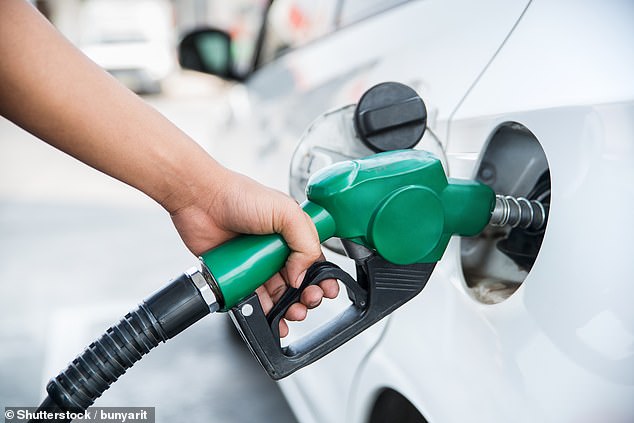The average pump price of petrol sold in the UK has fallen below 140p a litre for the first time in over two years, it has been confirmed.
On Wednesday 10 January, the average price of a litre of unleaded across the country dipped to 139.97p.
The last time petrol was recorded as being cheaper on average was on 13 October 2021 when it was 139.55p.
Yet, the AA says prices remain ‘historically very high’ and continue to pile pressure on families and businesses.

On Wednesday 10 January, the average price of a litre of unleaded across the country dipped to 139.97p. The last time petrol was that low was mid-October 2021, the AA says
The motoring group said diesel is now being sold by UK fuel stations for an average of 147.83p.
That is the cheapest national average since early August (147.33p on 3 August 2023).
While fuel price remain much higher than they were before Russia’s invasion of Ukraine and pre-pandemic, today’s costs are far lower than they were a year ago.
On 10 January 2023, the average price of petrol was 9.5p higher (149.47p) while diesel cost a whopping 24.1p more (171.93p).
For an average-size family car with a 55-litre fuel tank, this translates to a petrol saving of £5.23 for each time motorists fill up compared to a year ago.
Those with diesel models, the difference to fuel receipt to brim the tank is £13.26.
Set against the record highs at the beginning of July 2022 (petrol 191.53p on 3 July, diesel 199.07p on 1 July), petrol’s 51.56p drop means that UK car drivers are spending £28.36 less to fill the typical 55-litre tank (£76.98 versus £105.34).
For a business using vans with an 80-litre Transit size fuel tank, the cost of filling up has fallen from £159.26 to £118.26 – a saving of £41.
Commenting on the price of petrol dipping below 140p a litre this week, Luke Bosdet, the AA’s spokesman on pump prices, said: ‘While the dramatic improvement in pump prices gives big savings to families and businesses, and also redirects millions of pounds from fuel sales potentially back to the high street, pump prices remain historically very high.
Before Covid and the Ukraine war, the worst drivers faced was 142.48p record set in April 2012.
‘The danger is that current pump-price levels are baked in as the new normal.’
The AA’s report comes after the RAC confirmed that Britain’s drivers had benefited from a 6p per litre fall in petrol prices in December, making it the It the second consecutive monthly price cut, the RAC said.
However, it said pump prices should be reduced further as the average supermarket margin on fuel was 13p per litre last month, which is more than double what it was in 2021.
The motoring services company also noted that average fuel prices in Northern Ireland at the end of the month were 135.3p per litre for petrol and 144.2p per litre for diesel.
In July last year, competition watchdog the Competition and Markets Authority said pump prices are generally lower in Northern Ireland than the rest of the UK because of competition from forecourts in the Republic of Ireland.
RAC fuel spokesman Simon Williams said: ‘It’s clearly good news that both petrol and diesel came down substantially in December.
‘While we’re starting the year paying much less at the pumps than we have done, it’s still galling to know that drivers aren’t being charged a fair price in comparison to Northern Ireland where the very same petrol and diesel is at least 5p a litre cheaper.
‘It’s surely impossible to argue that competition is working properly if prices are so vastly different in two parts of the UK.
‘We continue to call on the biggest retailers to play fair with drivers and lower their prices to match what’s being charged in Northern Ireland.
‘We also urge Energy Security Secretary Claire Coutinho, who is on a mission to bring greater transparency to fuel pricing following the Competition and Markets Authority’s investigation concluding drivers were overcharged to the tune of £900 million in 2022, to ask the supermarkets why they won’t charge similar prices to the averages seen across Northern Ireland.’

The RAC says pump prices should be reduced further as the average supermarket margin on fuel was 13p per litre last month, which is more than double what it was in 2021
A Department for Energy Security and Net Zero spokesperson said: ‘The drop in petrol prices in the run-up to Christmas was good news for many hardworking families driving hundreds of miles across the country.
‘We want fuel prices to stay down for 2024 and beyond. That is why the Government is giving the competition watchdog tough new powers to oversee the market and make sure retailers pass on savings.
‘This stance is working, and we will continue progressing plans for fuel retailers to share up-to-date price information that will help customers to easily shop around for deals.’
Some links in this article may be affiliate links. If you click on them we may earn a small commission. That helps us fund This Is Money, and keep it free to use. We do not write articles to promote products. We do not allow any commercial relationship to affect our editorial independence.



